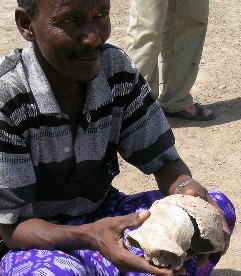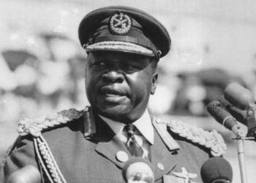Ancient trading Kingdoms of Ghana, Songhai, Mali, and Axum
AD 350 ~ AD 1590
Ghana, Kingdom of Gold
Trading kingdoms grew in West Africa more than one thousand years ago. In about 700, the kingdom of Ghana became powerful. There was much gold in Ghana. But Ghana did not have salt. Arab traders traveled across the Sahara desert in caravans to Ghana. A caravan is a group of traders traveling together. The caravans crossing the Sahara used camels. They traded their salt for Ghana’s gold. The traders also brought their religion to West Africa. It was called Islam. Islam’s followers are called Muslims. The kings of Ghana asked Muslims to help them rule the kingdom. Ghana’s kings grew rich by taxing the traded goods. The kingdom of Ghana became less powerful by the 1100s.
Mali and Songhai
The kingdom of Mali was also in West Africa. Mali was larger than Ghana. It also had a lot of gold, but no salt. Mali was very rich from trade. King Mansa Musa ruled Mali in the 1300s. He went on a pilgrimage, or religious journey, to Mecca. Mecca is a city that is special to Muslims. Mansa Musa traveled with thousands of people. He brought 500 slaves to carry his gold. The king brought back Muslim teachers and artists to the city of Timbuktu. This made Timbuktu a center of learning. Between 1300 and 1500, Songhai became another powerful kingdom in West Africa. In the early 1500s, Songhai controlled more land than Ghana and Mali.
The Kingdom of Aksum
In the sixth century, the kingdom of Aksum (Axum) was doing what many elsewhere had been doing: pursuing trade and empire. Despite the disintegration of the Roman Empire in the 400s and the decline in world trade, Aksum’s trade increased during that century. Its exports of ivory, glass crystal, brass and copper items, and perhaps slaves, among other things, had brought prosperity to the kingdom. Some people had become wealthy and cosmopolitan. Aksum’s port city on the Red Sea, Adulis, bustled with activity. Its agriculture and cattle breeding flourished. Aksum extended its rule to Nubia, across the Red Sea to Yemen, and it extended its rule to the northern Ethiopian Highlands and along the coast to Cape Guardafui.
Trading made these empires more wealthy, and opened the world for Africa.

Portuguese Trade
1400s
Portuguese came to search for gold. After setting up ports along the coast, they started trading gold and enslaved Africans, who were forced to go on a ship with many other slaves and face deadly conditions such as disease and lack of nutrition. Many businessmen and men of that sort supported the Europeans’ ways as well. The enslaved Africans were traded among colonies and with the Portuguese and French. The slaves worked in the fields producing crops; worked as, “paddle men” in the army; etc. Although, African kings and chiefs had been enslaving and trading Africans for centuries before the Portuguese started. The Portuguese often exploited local populations for benefits of their own.
Colonies and New Countries
1882-1914
Europeans began trading with Africans in 1200s. During 1600-1700s they traded gold and other goods, and for enslaved people. For raw material source and market, Europeans began colonization in Africa. Most of Africa was under European control by late 1800s. It was the most important event in modern history of Africa, colonies influenced the region’s languages, cultures, economies, and almost everywhere. But also it made African countries poorer.

Independence Movements
Mid 1900s-1961
Although many African colonies tried to resist colonial rule, most groups were unsuccessful until the mid-1900s. Under increasing pressure, Europeans power granted colonies independence throughout the mid-to-late 1900s. When countries gained independence, they often experience internal strife and conflict. Some countries, however, have remained relatively stable, such as Botswana and the island of Mauritius.

Apartheid
Early 1900s-1994
After South Africa became independent of Britain, the white minority in the country, known as Afrikaners, ran the government. It imposed a policy known as apartheid, or separation of the races and racial prejudice against non-white Africans. South Africans were denied political rights and equality with whites in many aspects of life, much like the United States before the Civil Rights movement. Internal unrest and international pressures forced South Africa to end apartheid. Nelson Mandela, a very popular anti-apartheid leader, was released after 27 years in prison. After South Africa’s first election based on universal suffrage in 1994, Mandela became the country’s first black president. Despite this massive success, many continue to live in poverty as an effect of the inequality that was an integral part of apartheid.
Sudan conflicts
1983-2005
Distinct cultural divisions occur between Sudan’s north and south. Arab-speaking Muslims live mostly in the north in the cities and favor Islamic-oriented governments. People in the south live mostly in rural areas, are focused on a subsistence economy, and prefer s secular government.
The civil war in Sudan began in 1983. During the course of the war, which ended in 2005,but it didn’t address the conflicts. The future is still uncertain. Two million people were killed and four million were made homeless. The war was mostly fought between the government and the SPLA (Sudanese People’s Liberation Army) who wanted control of Southern Sudan. The discovery of oil in the south caused further problems as the government did not want the south to take all the wealth from the oil. The Murahaleen – Arab fighters on horseback from the north of the country also assisted the government. Many homes were burnt down and entire villages destroyed. Women and girls were raped, children – especially boys – were kidnapped and put to work either as slaves or child soldiers. The SPLA could also be accused of similar atrocities. Many orphaned boys formed large walking groups and walked across the country to apparent safety in Ethiopia. For some this involved walks of up to several months. There was little food and water and many children died of thirst, starvation or by being taken by lions. Many refugees ended up in refugee camps in Ethiopia where conditions were not much better at first. Eventually, overseas aid arrived and food, clothes, medical aid and education were provided.
Many Sudanese have never returned home since the peace treaty in 2005. There are many reasons for this. Some refugees know nothing other than the life they have had in the camps as they were young children at the start of the war. For some of them, they no longer speak the local dialect of the area they came from as, being orphans, there were no family members to keep the languages alive. Many people cannot afford to return home as they have nothing to go back to. Their homes were destroyed and any wealth they had (mostly in the form of cattle) was taken by the Murahaleen raiders. Not speaking the local dialect will make finding employment difficult.
Origin of Humankind
3.2 million years ago
East Africa is considered the place of origin for all humankind. Archaeologists have discovered human bones dating back 3.2 million years in Ethiopia. In Kenya, that have found bones that are 2.6 million years old.
As all humankind’s origin, Africa has long history and long cultural history. This makes this region has plenty of products of arts, literature and music.
Uganda dictatorship
1966-1979
Idi Amin Dada, who became known as the ‘Butcher of Uganda’ for his brutal, despotic rule whilst president of Uganda in the 1970s, is possibly the most notorious of all Africa’s post-independence dictators. Amin seized power in a military coup in 1971 and ruled over Uganda for 8 years. Estimates for the number of his opponents who were either killed, tortured, or imprisoned vary from 100,000 to half a million. He was ousted in 1979 by Ugandan nationalists, after which he fled into exile.
During this time period, social disintegration, human rights violations, and economic decline happened. Made this new country faced internal strife and many difficulties.
Rwanda & Burundi
1959-1994
In Rwanda and Burundi, the colonial powers favored the Tutsi people gave them positions of power over Hutu. This created resentment among the Hutu. Violence erupted in 1959 between the two groups and continued for decades. Its culmination occurred in 1994 in the Rwanda genocide in which hundreds of thousands of Tutsi were killed by Hutu.
The civil war made this poor country lost plenty of labor,and made the economy declined. The structure of population was changed by the holocaust. Over 40% of population is children under 14 years old.
Works Cited
African History. N.p., n.d. Web. 1 Apr. 2013. <http://africanhistory.about.com/od/biography/a/bio_amin.htm>.
Boehm, Richard G., and Dinah Zike. Glencoe World Geography and Cultures. New York: McGraw, 2012. Print.
“Colonial Africa.” WordPress. N.p., n.d. Web. 31 Mar. 2013. <https://encrypted-tbn1.gstatic.com/images?q=tbn:ANd9GcQRLIP1z8NPHBhV7QH7MPB8ceX4eOWLGemdGFHp6CeBdLT8d7W>.
“Conflicts in Sudan.” Enough. N.p., n.d. Web. 1 Apr. 2013. <http://www.enoughproject.org/conflicts/sudans/conflicts-sudan>.
“Early African Empires and Their Global Connections.” Globaled. N.p., n.d. Web. 1 Apr. 2013. <http://www.globaled.org/nyworld/materials/african2.html>.
“Gold.” UTAFebruary2011AncientGhana. N.p., n.d. Web. 31 Mar. 2013. <http://3.bp.blogspot.com/-Wd1g1FTIJZs/TZY75AEyLTI/AAAAAAAAACo/N6P73iXwltg/s1600/gold%2Bin%2Bafrica.jpg>.
“Idi Amin Dada.” Darksideradioshow. N.p., n.d. Web. 1 Apr. 2013. <http://darksideradioshow.com/images/IdiAmin.png>.
“Sudan Soldiers.” War News Updates. N.p., n.d. Web. 31 Mar. 2013. <http://2.bp.blogspot.com/_PG3ew_iFi3A/SDOLUVvjvhI/AAAAAAAAA4w/jt4PnagHeAY/s400/photo1.jpg>.
<http://media.web.britannica.com/eb-media/46/109446-004-ECD1270A.jpg>
<http://www-cs-students.stanford.edu/~cale/cs201/pictures/crowd.jpg>
<http://news.bbcimg.co.uk/media/images/54229000/jpg/_54229066_tanzania_nyere_1961_g304.jpg>






I like your pictures! Obviously, Africa has had to struggle through some gruesome times, and those effects can still be seen today. Hopefully, by using something such as the girl effect, Africa can possibly get back on its feet (even if it’s wobbly).